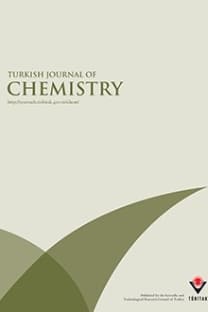Artificial intelligence-based models for the qualitative and quantitative prediction of a phytochemical compound using HPLC method
High performance liquid chromatography retention time, isoquercitrin, artificial intelligence, multilinear regression,
___
- Abba SI, 2020, CHEMOMETR INTELL LAB, V201, DOI 10.1016/j.chemolab.2020.104007
- Abba SI, 2020, J WATER PROCESS ENG, V33, DOI 10.1016/j.jwpe.2019.101081
- Ali TA, 2016, CHINESE J ANAL CHEM, V44, pE1601, DOI 10.1016/S1872-2040(16)60899-X
- Amini I, 2018, ADV J CHEM A, V1, P12, DOI DOI 10.29088/SAMI/AJCA.2018.3.1231
- Bi YM, 2015, CHINESE J ANAL CHEM, V43, P1086, DOI 10.1016/S1872-2040(15)60842-8
- D'Archivio AA, 2019, MOLECULES, V24, DOI 10.3390/molecules24030632
- Eisinga R, 2013, INT J PUBLIC HEALTH, V58, P637, DOI 10.1007/s00038-012-0416-3
- Elkiran G, 2018, GLOB J ENVIRON SCI M, V4, P439, DOI 10.22034/gjesm.2018.04.005
- Elkiran G, 2019, J HYDROL, V577, DOI 10.1016/j.jhydrol.2019.123962
- Emamghoreishi M, 2005, J ETHNOPHARMACOL, V96, P365, DOI 10.1016/j.jep.2004.06.022
- Erenler R, 2018, TURK J CHEM, V42, P1695, DOI 10.3906/kim-1712-3
- Granata F, 2017, WATER-SUI, V9, DOI 10.3390/w9020105
- Guddat S, 2011, DRUG TEST ANAL, V3, P836, DOI 10.1002/dta.372
- Khademi Faezehossadat, 2016, International Journal of Sustainable Built Environment, V5, P355, DOI 10.1016/j.ijsbe.2016.09.003
- Kim YJ, 2010, ANTIVIR RES, V88, P227, DOI 10.1016/j.antiviral.2010.08.016
- Korany MA, 2012, J ADV RES, V3, P53, DOI 10.1016/j.jare.2011.04.001
- Lian XH, 2019, CHINESE J ANAL CHEM, V47, P756, DOI 10.1016/S1872-2040(19)61160-6
- Lu J, 2018, CHINESE J ANAL CHEM, V46, pE1817, DOI 10.1016/S1872-2040(17)61082-X
- Mandal Shyamapada, 2015, Asian Pacific Journal of Tropical Biomedicine, V5, P421, DOI 10.1016/j.apjtb.2015.04.001
- Ng BK, 2016, TRAC-TREND ANAL CHEM, V80, P625, DOI 10.1016/j.trac.2015.07.015
- Orhan Ilkay, 2007, Phytochemistry Reviews, V6, P189, DOI 10.1007/s11101-006-9053-x
- Pham QB, 2019, WATER RESOUR MANAG, V33, P5067, DOI 10.1007/s11269-019-02408-3
- Ruggieri F, 2005, J CHROMATOGR A, V1076, P163, DOI 10.1016/j.chroma.2005.04.038
- Salem JH, 2010, PROCESS BIOCHEM, V45, P382, DOI 10.1016/j.procbio.2009.10.012
- Sheela KG, 2013, MATH PROBL ENG, V2013, DOI 10.1155/2013/425740
- Solgi A, 2017, ECOHYDROL HYDROBIOL, V17, P164, DOI 10.1016/j.ecohyd.2017.02.002
- Tuzen M, 2003, TURK J CHEM, V27, P49 .
- Usman AG, 2020, CHROMATOGRAPHIA, V83, P933, DOI 10.1007/s10337-020-03912-0
- Veenaas C, 2018, ANAL BIOANAL CHEM, V410, P7931, DOI 10.1007/s00216-018-1415-x
- Wang XY, 2018, CHINESE J ANAL CHEM, V46, P1695, DOI 10.1016/S1872-2040(18)61121-1
- Xiong XC, 2012, CHINESE J ANAL CHEM, V40, P43, DOI 10.1016/S1872-2040(11)60525-2
- Yalcin FN, 2008, TURK J CHEM, V32, P457 .
- Yu K, 2006, CHINESE J ANAL CHEM, V34, P561, DOI 10.1016/S1872-2040(06)60029-7
- ISSN: 1300-0527
- Yayın Aralığı: 6
- Yayıncı: TÜBİTAK
Gamze BOZKURT, Abdulkadir ÖZER, Ayşe BAYRAKÇEKEN YURTCAN
Ayşe BOZAN, Rahime SONGÜR, Ülkü MEHMETOĞLU
A novel molecular imprinting polymer for the selective adsorption of D-arabinitol from spiked urine
Siswandono SISWODIHARDJO, Yuni RETNANINGTYAS, Ganden SUPRIYANTO, Ni NYOMAN TRI PUSPANINGSIH, Roedi IRAWAN
Evin Sahin SADİK, Hamdi Melih SARAOGLU, Ilke GUROL, Mehmet Ali EBEOGLU, Fatma Emel KOCAK
Selin IŞIK, Abdullahi Garba USMAN, Sani Isah ABBA, Filiz MERİÇLİ
Yuni RETNANİNGTYAS, Ganden SUPRİYANTO, Ni NYOMAN TRİ PUSPANİNGSİH, Roedi IRAWAN, Siswandono SİSWODİHARDJO
Syed Adnan Ali SHAH, Nasir RASOOL, Hafiz Mansoor IKRAM, Ammara RASHID, Nazia AFZAL, Muhammad Ali HASHMI, Muhammad Naeem KHAN, Ayesha KHAN, Imran IMRAN, Hafiz Muhammad Abdur RAHMAN
Maqsood MARYAM, Sang Loon TAN, Karen Ann CROUSE, Mohamed Ibrahim MOHAMED TAHIR, Hui Yee CHEE
